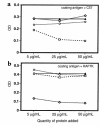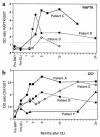Detection of a potent humoral response associated with immune-induced remission of chronic myelogenous leukemia
- PMID: 10974024
- PMCID: PMC381287
- DOI: 10.1172/JCI10196
Detection of a potent humoral response associated with immune-induced remission of chronic myelogenous leukemia
Abstract
The effectiveness of donor-lymphocyte infusion (DLI) for treatment of relapsed chronic myelogenous leukemia (CML) after allogeneic bone marrow transplantation is a clear demonstration of the graft-versus-leukemia (GVL) effect. T cells are critical mediators of GVL, but the antigenic targets of this response are unknown. To determine whether patients who respond to DLI also develop B-cell immunity to CML-associated antigens, we analyzed sera from three patients with relapsed CML who achieved a complete molecular remission after infusion of donor T cells. Sera from these individuals recognized 13 distinct gene products represented in a CML-derived cDNA library. Two proteins, Jkappa-recombination signal-binding protein (RBP-Jkappa) and related adhesion focal tyrosine kinase (RAFTK), were recognized by sera from three of 19 DLI responders. None of these antigens were recognized by sera from healthy donors or patients with chronic graft-versus-host disease. Four gene products were recognized by sera from CML patients treated with hydroxyurea and nine were detected by sera from CML patients who responded to IFN-alpha. Antibody titers specific for RAFTK, but not for RBP-Jkappa, were found to be temporally associated with the response to DLI. These results demonstrate that patients who respond to DLI generate potent antibody responses to CML-associated antigens, suggesting the development of coordinated T- and B-cell immunity. The characterization of B cell-defined antigens may help identify clinically relevant targets of the GVL response in vivo.
Figures



References
-
- Gale RP, et al. Survival with bone marrow transplantation versus hydroxyurea or interferon for chronic myelogenous leukemia. The German CML Study Group. Blood. 1998;91:1810–1819. - PubMed
-
- van Rhee F, et al. Long-term results after allogeneic bone marrow transplantation for chronic myelogenous leukemia in chronic phase: a report from the Chronic Leukemia Working Party of the European Group for Blood and Marrow Transplantation. Bone Marrow Transplant. 1997;20:553–560. - PubMed
-
- Gratwohl A, et al. Acute graft-versus-host disease: grade and outcome in patients with chronic myelogenous leukemia. Working Party Chronic Leukemia of the European Group for Blood and Marrow Transplantation. Blood. 1995;86:813–818. - PubMed
-
- Horowitz MM, et al. Graft-versus-leukemia reactions after bone marrow transplantation. Blood. 1990;75:555–562. - PubMed
-
- Sehn LH, et al. Comparative outcomes of T-cell-depleted and non-T-cell-depleted allogeneic bone marrow transplantation for chronic myelogenous leukemia: impact of donor lymphocyte infusion. J Clin Oncol. 1999;17:561–568. - PubMed
Publication types
MeSH terms
Substances
Associated data
- Actions
- Actions
- Actions
Grants and funding
LinkOut - more resources
Full Text Sources
Other Literature Sources
Medical
Miscellaneous

